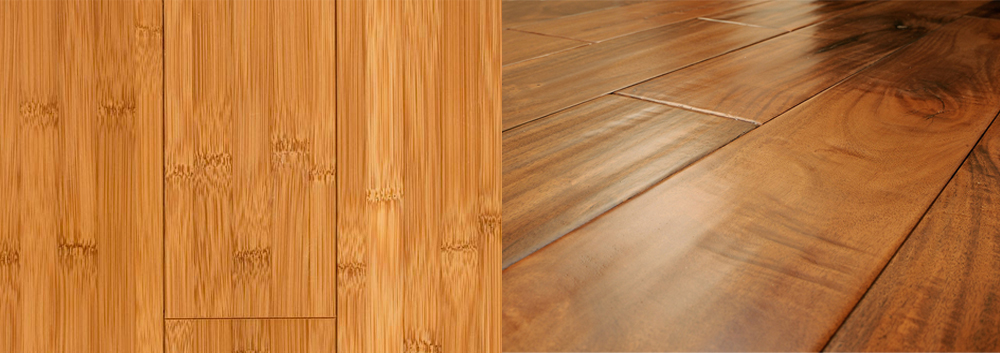
When choosing flooring for your home or office, the variety of options can be overwhelming. Bamboo flooring has grown in popularity for its sustainability, aesthetic appeal, and durability. However, how does it compare to other types of flooring like hardwood, laminate, vinyl, and tile? This comprehensive comparison will help you make an informed decision by exploring the pros, cons, costs, and performance of bamboo flooring against other common flooring options.
1. Bamboo Flooring Overview
What is Bamboo Flooring? Bamboo flooring is made from the bamboo plant, a rapidly renewable resource. It comes in various styles, such as horizontal, vertical, and strand-woven, offering diverse aesthetics and strength levels.
Key Features of Bamboo Flooring:
- Eco-friendly and sustainable.
- Comparable hardness to traditional hardwoods.
- Available in a range of colors and textures.
- Resistant to moisture (especially strand-woven bamboo).
Applications: Bamboo flooring works well in living rooms, bedrooms, and dining areas. However, its moisture-resistant properties make it suitable for kitchens and even bathrooms, provided it is properly sealed.
2. Bamboo vs. Hardwood Flooring
| Feature | Bamboo Flooring | Hardwood Flooring |
|---|---|---|
| Durability | Strand-woven bamboo is harder than most hardwoods. | Durable, varies by wood species. |
| Sustainability | Highly sustainable; bamboo matures in 5-7 years. | Longer growth cycles (20-100 years). |
| Appearance | Modern and sleek; limited grain patterns. | Classic and traditional; diverse grain patterns. |
| Cost | $5-$8 per sq. ft. | $6-$15 per sq. ft. |
| Moisture Resistance | More resistant, especially strand-woven types. | Susceptible unless sealed. |
| Maintenance | Easy to clean; periodic refinishing required. | Requires regular cleaning and refinishing. |
Verdict: Bamboo flooring is an eco-friendly and cost-effective alternative to hardwood. However, hardwood’s timeless appeal and extensive range of species give it a competitive edge for traditional spaces.
3. Bamboo vs. Laminate Flooring
| Feature | Bamboo Flooring | Laminate Flooring |
| Durability | Scratch-resistant, strand-woven options are highly durable. | Scratch-resistant but can chip. |
| Eco-Friendliness | Renewable resource. | Made from synthetic materials. |
| Appearance | Natural and unique. | Can mimic wood but lacks authenticity. |
| Cost | $5-$8 per sq. ft. | $2-$5 per sq. ft. |
| Water Resistance | Moderately water-resistant. | Limited water resistance. |
| Installation | Can be nailed or glued. | Click-lock installation; DIY-friendly. |
Verdict: Laminate flooring is budget-friendly and easy to install, but bamboo offers a more natural look and better environmental credentials.
4. Bamboo vs. Vinyl Flooring
| Feature | Bamboo Flooring | Vinyl Flooring |
| Durability | Highly durable, especially strand-woven. | Extremely durable and resilient. |
| Eco-Friendliness | Renewable and biodegradable. | Non-biodegradable; synthetic. |
| Appearance | Natural wood-like aesthetics. | Available in a wide range of designs. |
| Cost | $5-$8 per sq. ft. | $3-$7 per sq. ft. |
| Water Resistance | Moderate to high. | 100% waterproof. |
| Comfort | Hard underfoot. | Softer and more comfortable. |
Verdict: Vinyl is better suited for areas prone to moisture, such as bathrooms. However, bamboo is a more sustainable and visually appealing choice for living spaces.
5. Bamboo vs. Tile Flooring
| Feature | Bamboo Flooring | Tile Flooring |
| Durability | Resistant to wear and tear. | Extremely durable; scratch-proof. |
| Eco-Friendliness | Sustainable. | Not typically eco-friendly. |
| Appearance | Warm and natural look. | Cold and varied designs. |
| Cost | $5-$8 per sq. ft. | $5-$15 per sq. ft. |
| Water Resistance | Moderate to high. | 100% waterproof. |
| Comfort | Warmer underfoot than tile. | Cold and hard underfoot. |
Verdict: Tiles are ideal for wet areas due to their waterproof nature, but bamboo offers a cozier and more sustainable alternative.
6. Bamboo vs. Carpet Flooring
| Feature | Bamboo Flooring | Carpet Flooring |
| Durability | Longer-lasting; resistant to dents. | Prone to wear and staining. |
| Eco-Friendliness | Renewable resource. | Typically synthetic, less eco-friendly. |
| Appearance | Sleek and modern. | Soft and varied textures. |
| Cost | $5-$8 per sq. ft. | $3-$7 per sq. ft. |
| Maintenance | Easy to clean. | High-maintenance; requires frequent vacuuming. |
| Comfort | Hard underfoot. | Soft and warm underfoot. |
Verdict: Carpet provides unmatched comfort, but bamboo is a durable, stylish, and eco-conscious choice for households looking for sustainability.
7. Factors to Consider When Choosing Flooring
- Location and Usage: Consider moisture levels and foot traffic.
- Budget: Bamboo offers mid-range pricing with excellent value.
- Aesthetic Appeal: Bamboo provides a natural and modern look.
- Maintenance: Bamboo is easier to clean compared to carpet and tile.
- Environmental Impact: Bamboo stands out as one of the most eco-friendly options.
8. Final Recommendations
- Best for Eco-Conscious Buyers: Bamboo Flooring.
- Best for High-Moisture Areas: Vinyl or Tile Flooring.
- Best for Comfort: Carpet Flooring.
- Best for Traditional Elegance: Hardwood Flooring.
- Best for Budget-Friendly Options: Laminate Flooring.
Choosing the right flooring comes down to your priorities. Bamboo is a versatile, stylish, and sustainable option that bridges the gap between aesthetics, durability, and eco-friendliness.